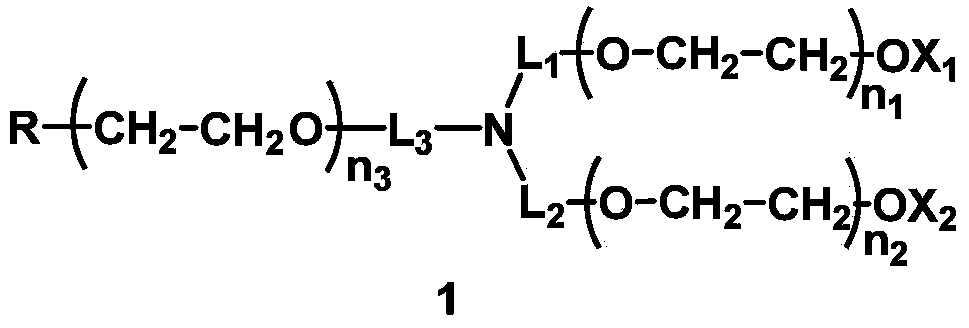Mono-functionalized polyethylene glycol with nitrogen atom branched center and its preparation method and biologically-relevant matter
A technology of polyethylene glycol and functionalization, which is applied in the direction of medical preparations and pharmaceutical formulations of non-active ingredients, and can solve the problems of limited small molecule initiator preparation, low carbon atom reactivity, and limited branched polyethylene glycol Issues such as types and usage, to achieve the effects of enriching types, strengthening protection, and improving conditions
- Summary
- Abstract
- Description
- Claims
- Application Information
AI Technical Summary
Problems solved by technology
Method used
Image
Examples
preparation example Construction
[0294] 1.1 Preparation of intermediate compound (3)
[0295] The intermediate compound (3) of the present invention can be produced as described below. 2 to 2000 times the molar amount of ethylene oxide and the compound (4) containing two exposed hydroxyl groups protected by terminal hydroxyl groups are polymerized, and an excess of deprotonating reagent is added to generate polyethylene glycol with two branched chains Anion intermediate (5); Hydrocarbon group X for terminal oxygen anion 1 、X 2 The intermediate compound (6) is obtained by etherification and capping; the terminal hydroxyl group of the main chain is deprotected; the newly formed terminal hydroxyl group of the main chain initiates the polymerization of ethylene oxide, and a proton source is added to obtain the intermediate compound (3). (i.e. steps a to d above).
[0296] 1.1.1 Preparation of polyethylene glycol anion intermediate (5) (step a)
[0297] The preparation of the intermediate (5) comprises two ste...
Embodiment 1
[0660] Embodiment 1: R is the preparation of monofunctional branched polyethylene glycol when class H
[0661] Preparation of Compound H1-1
[0662] In this example, the H-like compound selected L 1 =CH 2 CH 2 , L 2 =CH 2 CH 2 , L 3 =CH 2 CH 2 ,X 1 =X 2 =CH 3 , q=0, the protecting group PG of the terminal hydroxyl group of the main chain of the small molecule initiator 4 =TBS. The total molecular weight is designed to be about 20000, and the molecular weight of the two branched chains is about 2*8500=17000, namely n 1 ≈n 2 ≈193; the molecular weight of the main chain containing active functional groups is about 3000, that is, n 3 ≈68.
[0663]
[0664] a. In an anhydrous and oxygen-free airtight reaction kettle, add tetrahydrofuran (250mL), small molecule initiator (2.532mmol) and diphenylmethyl potassium (4.0mmol) successively;
[0665] b, adding calculated amount of ethylene oxide (50mL), gradually warming up to a temperature of 60°C, and reacting for 48 ...
Embodiment 2
[0766] The preparation of embodiment 2 active ester derivatives
[0767] Synthesis of Active Ester A1-1
[0768] The synthesis of active ester (A1-1), wherein L 1 =CH 2 CH 2 , L 2 =CH 2 CH 2 , L 3 =CH 2 CH 2 ,X 1 =X 2 =CH 3 , q=0, the molecular weight is about 20000, where n 1 , n 2 , n 3 The value of is the same as that of compound H1-1. In this example, the corresponding active ester was directly prepared by reacting the hydroxyl group at the end of the main chain containing the active functional group of compound H1-1 with carbonate.
[0769]
[0770] In a dry and clean 1L round bottom flask, add 40g of branched polyethylene glycol (H1-1, dewatered by azeotropic toluene) prepared in Example 1, 500mL of acetonitrile, 40mL of triethylamine and 10g of N,N' - Disuccinimidyl carbonate, reacted at room temperature for 24 hours, concentrated, and recrystallized from isopropanol to obtain active ester (A1-1) as a white solid.
[0771] The hydrogen spectrum data ...
PUM
 Login to View More
Login to View More Abstract
Description
Claims
Application Information
 Login to View More
Login to View More - R&D
- Intellectual Property
- Life Sciences
- Materials
- Tech Scout
- Unparalleled Data Quality
- Higher Quality Content
- 60% Fewer Hallucinations
Browse by: Latest US Patents, China's latest patents, Technical Efficacy Thesaurus, Application Domain, Technology Topic, Popular Technical Reports.
© 2025 PatSnap. All rights reserved.Legal|Privacy policy|Modern Slavery Act Transparency Statement|Sitemap|About US| Contact US: help@patsnap.com



